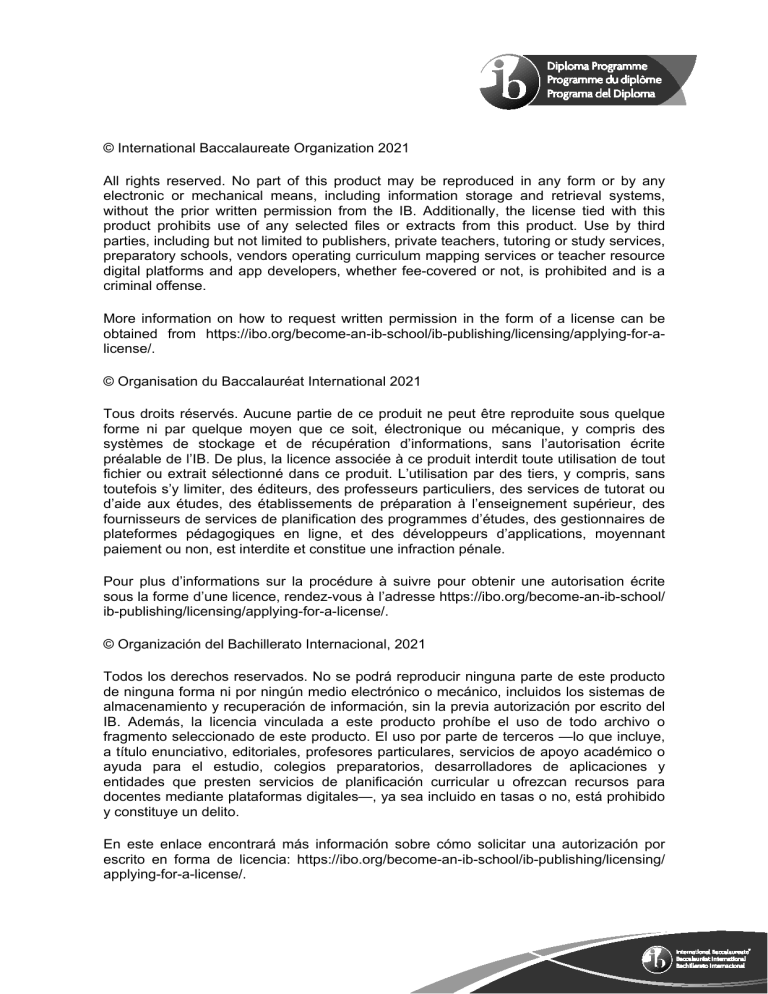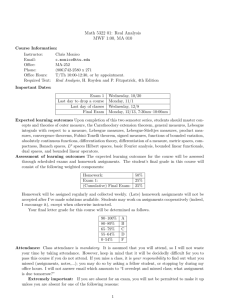
© International Baccalaureate Organization 2021 All rights reserved. No part of this product may be reproduced in any form or by any electronic or mechanical means, including information storage and retrieval systems, without the prior written permission from the IB. Additionally, the license tied with this product prohibits use of any selected files or extracts from this product. Use by third parties, including but not limited to publishers, private teachers, tutoring or study services, preparatory schools, vendors operating curriculum mapping services or teacher resource digital platforms and app developers, whether fee-covered or not, is prohibited and is a criminal offense. More information on how to request written permission in the form of a license can be obtained from https://ibo.org/become-an-ib-school/ib-publishing/licensing/applying-for-alicense/. © Organisation du Baccalauréat International 2021 Tous droits réservés. Aucune partie de ce produit ne peut être reproduite sous quelque forme ni par quelque moyen que ce soit, électronique ou mécanique, y compris des systèmes de stockage et de récupération d’informations, sans l’autorisation écrite préalable de l’IB. De plus, la licence associée à ce produit interdit toute utilisation de tout fichier ou extrait sélectionné dans ce produit. L’utilisation par des tiers, y compris, sans toutefois s’y limiter, des éditeurs, des professeurs particuliers, des services de tutorat ou d’aide aux études, des établissements de préparation à l’enseignement supérieur, des fournisseurs de services de planification des programmes d’études, des gestionnaires de plateformes pédagogiques en ligne, et des développeurs d’applications, moyennant paiement ou non, est interdite et constitue une infraction pénale. Pour plus d’informations sur la procédure à suivre pour obtenir une autorisation écrite sous la forme d’une licence, rendez-vous à l’adresse https://ibo.org/become-an-ib-school/ ib-publishing/licensing/applying-for-a-license/. © Organización del Bachillerato Internacional, 2021 Todos los derechos reservados. No se podrá reproducir ninguna parte de este producto de ninguna forma ni por ningún medio electrónico o mecánico, incluidos los sistemas de almacenamiento y recuperación de información, sin la previa autorización por escrito del IB. Además, la licencia vinculada a este producto prohíbe el uso de todo archivo o fragmento seleccionado de este producto. El uso por parte de terceros —lo que incluye, a título enunciativo, editoriales, profesores particulares, servicios de apoyo académico o ayuda para el estudio, colegios preparatorios, desarrolladores de aplicaciones y entidades que presten servicios de planificación curricular u ofrezcan recursos para docentes mediante plataformas digitales—, ya sea incluido en tasas o no, está prohibido y constituye un delito. En este enlace encontrará más información sobre cómo solicitar una autorización por escrito en forma de licencia: https://ibo.org/become-an-ib-school/ib-publishing/licensing/ applying-for-a-license/. English A: language and literature – Standard level – Paper 1 Anglais A : langue et littérature – Niveau moyen – Épreuve 1 Inglés A: Lengua y Literatura – Nivel Medio – Prueba 1 Monday 10 May 2021 (afternoon) Lundi 10 mai 2021 (après-midi) Lunes 10 de mayo de 2021 (tarde) 1 h 15 m Instructions to candidates y Do not open this examination paper until instructed to do so. y Write a guided analysis of text 1 or text 2. y Use the guiding question or propose an alternative technical or formal aspect of the text to focus your analysis. y The maximum mark for this examination paper is [20 marks]. Instructions destinées aux candidats y N’ouvrez pas cette épreuve avant d’y être autorisé(e). y Rédigez une analyse dirigée du texte 1 ou du texte 2. y Utilisez la question d’orientation ou proposez une autre manière d’aborder le texte en choisissant un aspect technique ou formel sur lequel concentrer votre analyse. y Le nombre maximum de points pour cette épreuve d’examen est de [20 points]. Instrucciones para los alumnos y No abra esta prueba hasta que se lo autoricen. y Escriba un análisis guiado del texto 1 o del texto 2. y Utilice la pregunta de orientación o proponga otro aspecto técnico o formal del texto en el que centrar su análisis. y La puntuación máxima para esta prueba de examen es [20 puntos]. 5 pages/páginas 2221 – 2017 © International Baccalaureate Organization 2021 –2– 2221 – 2017 Write a guided analysis of one of the following texts. 1. The following is an extract from India’s Soul Food by Julie Sahni, who is famous for writing about Indian cooking, published in The New York Times Magazine. The New York Times Magazine BY Julie Sahni FOOD; INDIA’S SOUL FOOD 5 10 15 20 25 30 TO AN INDIAN FAMILY, THE tandoori meal is not just food. Like Sunday supper for some Americans, this meal is the high point of the week. I remember gathering with my family and friends in cool breezes at an outdoor concert in New Delhi under tamarind and mango trees. There, we would dig a pit to smoke, grill and roast chicken and meat. As the juicy morsels of meat were taken from the pit, we’d devour them instantly. Although tandoori cooking has become synonymous with India, it is not an Indian invention. Tandoor originated in Syria, then spread through Central Asia, including India, as a clay pit for baking bread. In the beginning of the 19th century, in Peshawar, in the northwest frontier region of Pakistan, then part of India, an ingenious technique for cooking meat was invented. Meat was first trimmed of all fat, then marinated for hours in a special yogurt and herb mixture. The tenderized meat and poultry was skewered on spears and lowered into the glowing hot tandoor. After being simultaneously baked, roasted, grilled and smoked, the meat was tender and moist, imbued with a sweet smoky aroma and a rich flavor. The Pathans called this tandoori food. To ensure that it was mistaken for no other, they colored it bright orange – a trademark of all tandoori foods today. The appeal of tandoori food is not surprising: children and adults alike love its mild herbal flavor. Because the food is trimmed of all fat and marinated in yogurt, it is low in fat and cholesterol. Tandoori food has not always been popular. As recently as 1947, when the first tandoori restaurant opened in India, this food was labeled low-class. A visit to a tandoori joint was taboo for members of society. This is probably because it was born not in a state, or royal, kitchen, but in the open air among nomadic tribes. Tandoori food was meant to be enjoyed with wine and music. Eventually, however, many members of the upper classes drove in limousines to the narrow alleyways, where they sent their servants to pick up tandoori food. Tandoori cooking is simple. It requires little time, effort or skill. The yogurt marinade reduces the cooking time considerably, because the marinade breaks down the protein in the meat. Almost any food that can be barbecued can be cooked in a tandoori oven. But many people never attempt tandoori cooking at home because they assume that it requires the tandoor clay oven. In fact, a traditional tandoori oven is not necessary for its preparation. What’s most important is the enclosed heat, and a covered grill with an adjustable air vent is excellent for this. The kettle –3– 2221 – 2017 grill with a domed lid works best because it reflects heat most evenly. The fire should be made with wood charcoal because it burns hotter than charcoal briquettes. Fresh or pre-soaked dried grapevine cuttings added just before barbecuing can substitute for the clay aroma of a true tandoori oven. Dried grapevines are sold at many specialty food stores. The vines should be soaked in water one hour before cooking. 35 The marinade ingredients vary slightly, depending on the meat used. For chicken, a marinade with olive oil lends an earthy aroma. Cornish hens or small broilers are more flavorful and absorb the marinade better than roasting chickens. Saffron is essential in the marinade for tandoori squab or quail to balance the rich gamy flavor of these birds. 40 Tandoori cooking need not be restricted to meat and poultry alone. Fresh fish, shellfish and vegetables work wonderfully, too. Take precaution not to over-marinate shrimp, or they will turn pasty during cooking. 45 – Discuss how different features are used on this webpage to create an impression of Indian culture. Turn over / Tournez la page / Véase al dorso –4– 2221 – 2017 2. The following is an infographic summarizing updated UK government medical advice on the importance of a high level of activity for children from birth to five years. * * ‘tummy time’ refers to giving your baby time on its tummy, under supervision, as it is important for the baby’s development and helps them learn to crawl and walk. –5– – 2221 – 2017 Comment on how the interplay of text and images is used to appeal to multiple audiences. Disclaimer: Texts used in IB language assessments are taken from authentic, third-party sources. The views expressed within them belong to their individual authors and do not necessarily reflect the views of the IB. References: 1. Sahni, J., 1988. India’s Soul Food. The New York Times Magazine. Available at: https://www.nytimes. com/1988/08/21/magazine/food-india-s-soul-food.html [accessed 03 September 2020]. [Image] Available at: https://www.pikist.com/free-photo-stawk [accessed 15 September 2020]. 2. UK government, 2019. Physical Activity Guidelines. Available at: https://assets.publishing.service.gov.uk/government/ uploads/system/uploads/attachment_data/file/829882/1-physical-activity-for-early-years-birth-to-5.pdf [accessed 03 September 2020]. Contains public sector information licensed under the Open Government Licence v3.0.



